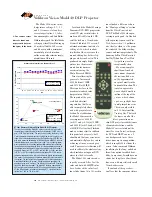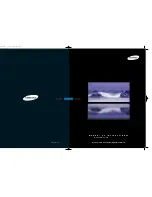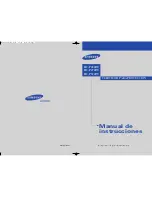
110
Home Theater /
November 2003 •
www.hometheatermag.com
G E A R G U I D E
detection for film-based material,
good color decoding, and a nice
features package. It’s also competi-
tively priced and, as such, is an
excellent value in its category.
The Model 40 has a compact,
squarish design with a white finish.
It measures 4.75 inches high by
15.75 wide by 13.625 deep and
weighs a reasonable 15 pounds.
The unit has a very solid feel,
which indicates good build quality.
The lens is offset slightly from the
center of the pro-
jector. Some of
the remote’s most
commonly used
buttons are also on
the top of the unit,
such as power,
menu, input, enter,
exit, and the arrow keys
for navigation within the menu
system. Heat is vented through
the front of the projector, and
there’s virtually no light leakage
from the lamp.
The remote control, while not
backlit, is fully illuminated by glow-
in-the-dark buttons. The remote
does offer discrete access to all of
the projector’s inputs, aspect ratios,
and memories, which is very
important to a custom installer
who’s trying to integrate these
functions into a Crestron or AMX
touchpanel control system.
The connectivity suite, which
is located on the projector’s rear
panel, is fairly comprehensive.
You get one 480i-only component
video input with RCA connections,
plus a set of RGB inputs with H
and V sync; if you use only the R,
G, and B inputs, this connection
doubles as a high-bandwidth com-
ponent video input that’s capable
of displaying 480i/p, 720p, and
1080i sources. Of course, the oblig-
atory composite and S-video inputs
are also here (one of each), as well
as a DVI input with HDCP copy
protection for use with the new
crop of satellite and cable HDTV
receivers. Finally, Vidikron pro-
vides an RS-232 port for integrated
control systems like the above-
mentioned Crestron and AMX
touchpanel systems.
The Model 40 has few, if any,
consumer-type features, but that’s
to be expected with any front pro-
jector. However, it does offer a
few notable picture-enhancing
features, including a nine-point
system for calibrating
the gray scale that
gives the professional
installer and/or video
technician unprece-
dented flexibility in
this important setup
area. You also can set the gray
scale and all other picture parame-
ters for each input separately. A
total of 21 separate memory loca-
tions gives you more flexibility
than you’re likely to ever need in
terms of optimizing the picture for
all video and computer sources.
For added versatility, you can
choose either a short-throw lens
(1.38:1 to 1.63:1), or, for an addi-
tional $1,000, you can opt for the
long-throw lens (1.83:1 to 2.40:1).
DLP projectors have become all the
rage in the front-projection home
theater arena, thanks in large part
to the 1,280-by-720 chips that hit
the market a little over two years
ago. These chips raised the bar in
picture quality for
affordable high-end front pro-
jection. Vidikron, a front-projection
home theater pioneer, was recently
purchased by Runco International
and has launched a new line of
DLP projectors.
The company’s Vision Model 40
is a one-chip DLP projector with
a native resolution of 1,280 by
720, and it’s based on the second-
generation HD2 (or Mustang)
DMD chip. Compared with the
first-generation chip, this one defi-
nitely delivers better black-level
performance and a higher con-
trast ratio. The Model 40 has solid
video processing with 3:2-pulldown
Vidikron Vision Model 40
DLP Projector
Possibly the best value in high-resolution
one-chip DLP projectors.
by Kevin Miller
A.
The Model 40 has
a 1,280-by-720 reso-
lution and utilizes
the HD2 chip.
B.
Take your pick of
connection options,
including a DVI input
with HDCP.
A
B





















